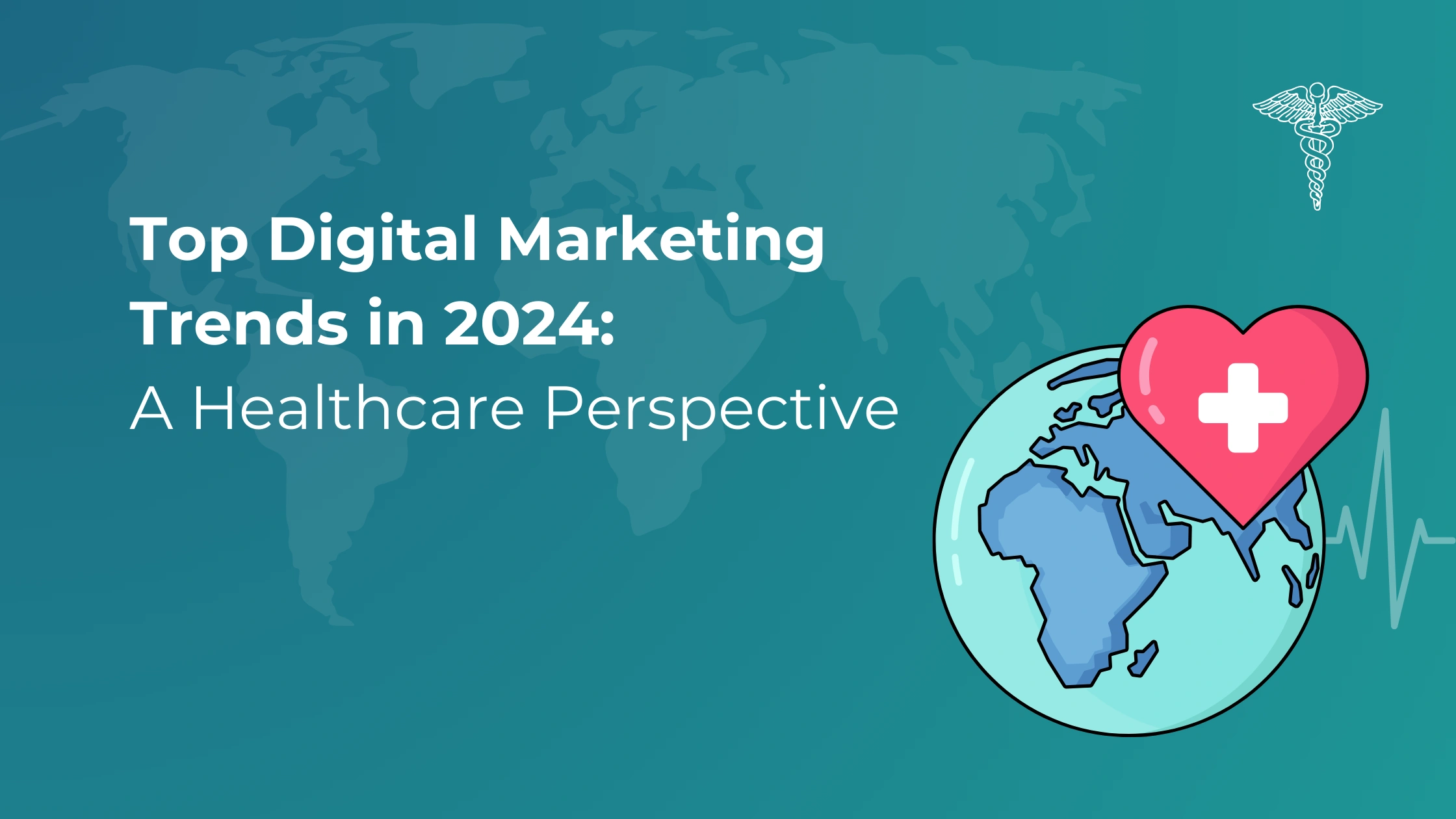As digital marketing strategies rapidly evolve, the healthcare sector in 2024 is witnessing unprecedented changes. Leveraging digital tools in healthcare marketing has become essential not just for enhancing patient engagement and building trust but also for ensuring compliance with data security standards and addressing unique patient needs. Here, we explore the key trends shaping the healthcare digital marketing landscape in 2024 and discuss strategies for harnessing these trends to reach and support patients effectively.
1. Telehealth and Virtual Care Promotion

- Why It Matters: Telehealth has grown exponentially, supported by both patient demand for convenience and advancements in telemedicine technologies. The global telehealth market is projected to exceed $250 billion by 2025.
- Strategy: Digital campaigns should emphasize telehealth’s safety, ease of access, and versatility. Educating patients on navigating virtual platforms and promoting services via video marketing can help increase telehealth engagement and adoption.
2. Personalization in Marketing
- Why It Matters: Personalized marketing experiences can increase patient engagement by over 80%. Patients expect healthcare providers to cater to their unique needs and offer tailored solutions.
- Strategy: Leveraging CRM systems to segment audiences based on patient history and preferences allows healthcare organizations to deliver personalized content. Personalized email marketing campaigns and dynamic website content also ensure patients feel understood and valued.
3. Data Privacy and Security
- Why It Matters: With the rise of digital platforms in healthcare, protecting sensitive patient data has become paramount. Surveys reveal that nearly 70% of patients are more likely to trust providers who prioritize data privacy.
- Strategy: Emphasize compliance with regulations such as HIPAA in the U.S. and GDPR in Europe. By building patient trust through clear data protection policies and secure patient portals, healthcare providers can foster loyalty.
4. Artificial Intelligence (AI) and Chatbots
- Why It Matters: AI chatbots are projected to save the healthcare industry nearly $3.6 billion globally by 2026 by streamlining patient interactions.
- Strategy: AI-driven chatbots can provide 24/7 patient assistance, answer basic inquiries, help with appointment scheduling, and guide patients through common processes. Additionally, AI tools can analyze data to suggest individualized treatment options, enhancing patient satisfaction and reducing response times.

5. Content Marketing
- Why It Matters: Studies show that patients are more likely to engage with providers that offer informative content. Content marketing in healthcare fosters a sense of trust and positions providers as experts.
- Strategy: Creating a comprehensive library of informative blogs, videos, and infographics can address patients’ educational needs. Topics should include preventive care, wellness advice, and treatment information to empower patients and encourage proactive health management.

6. Social Media Engagement
- Why It Matters: 90% of millennials and over 65% of Gen Z use social media for health information. Social media platforms offer direct, informal ways to engage patients and share valuable health insights.
- Strategy: Maintain an active presence on platforms like Instagram, Facebook, and LinkedIn. Live Q&A sessions, patient testimonials, and expert-led webinars are effective in building a supportive online community and improving patient outreach.
7. Mobile Optimization
- Why It Matters: As mobile devices become the primary source for online health information, optimizing for mobile is crucial. Mobile-friendly websites improve patient satisfaction by over 70%.
- Strategy: Healthcare websites must be responsive, featuring easy navigation, quick loading, and optimized visuals for a seamless mobile experience. Mobile app integration for appointment scheduling and telemedicine consultations can further enhance patient convenience.
8. Augmented Reality (AR) in Patient Education
- Why It Matters: AR can elevate patient education, especially for complex treatments, by providing interactive visuals and making procedures easier to understand.
- Strategy: AR apps and website integrations enable patients to visualize medical procedures and treatment plans in real-time, increasing comprehension and reducing anxiety.
9. Predictive Analytics for Targeted Campaigns
- Why It Matters: Predictive analytics helps in proactive healthcare management by identifying patients who may benefit from specific services based on their history and demographics.
- Strategy: Using historical patient data, healthcare providers can create seasonal campaigns that address patients’ needs, like flu season reminders. Predictive insights can also guide providers on patient follow-up timing, increasing engagement.
10. Programmatic Advertising
- Why It Matters: Programmatic advertising automates ad placements, ensuring messages reach relevant audiences with precision. Healthcare providers can see up to a 30% increase in conversion rates.
- Strategy: Use programmatic ads to promote wellness campaigns or localized health services, ensuring the right message reaches the target demographic efficiently and cost-effectively.
11. Voice-Activated Technology in Healthcare Marketing
- Why It Matters: As over 50% of searches are voice-activated, optimizing content for voice search ensures that healthcare providers remain accessible to patients who use these devices.
- Strategy: Updating SEO strategies to incorporate conversational keywords and common voice queries enables better reach for patients searching for healthcare services via smart devices.

12. Geotargeting for Local Healthcare Services
- Why It Matters: Geotargeting enables healthcare providers to reach patients based on geographic location, ideal for promoting region-specific services.
- Strategy: Using location-based marketing, clinics can promote events, screenings, or specialty consultations to residents in nearby areas, increasing patient turnout.
13. Enhanced UX Design for Healthcare Websites
- Why It Matters: Patient-friendly UX on healthcare websites improves accessibility, reduces abandonment rates, and ensures a positive patient experience.
- Strategy: Websites should feature intuitive navigation, responsive design, and accessible content. Clear call-to-action buttons and minimal form fills improve patient satisfaction and retention.
14. ESG (Environmental, Social, Governance) Marketing
- Why It Matters: Patients are increasingly interested in the values of healthcare providers. 75% of patients are more likely to choose providers demonstrating social and environmental responsibility.
- Strategy: Highlight eco-friendly initiatives, community engagement, and ethical practices to build a positive brand image and establish trust.
15. Comprehensive Patient Journey Mapping
- Why It Matters: Mapping the patient journey helps healthcare providers improve engagement and satisfaction at each step of the healthcare process.
- Strategy: Identifying patient touchpoints and sending automated reminders or follow-up messages at each stage supports a smooth and positive patient journey, boosting overall retention.
Case Studies:

Telehealth Promotion Success
Health systems using programmatic ads to boost telemedicine awareness report a 30% increase in bookings, demonstrating the value of targeted advertising in patient engagement.
AR in Patient Education
Clinics that implemented AR tools for patient education observed higher patient satisfaction rates, as interactive visuals helped patients better understand their conditions and treatments.
Conclusion
In 2024, healthcare providers must adopt forward-thinking, patient-centric digital marketing strategies to stay competitive. By embracing these trends—from telehealth promotion to predictive analytics and personalized marketing—healthcare organizations can strengthen patient relationships, ensure privacy compliance, and ultimately foster long-term trust and loyalty.



